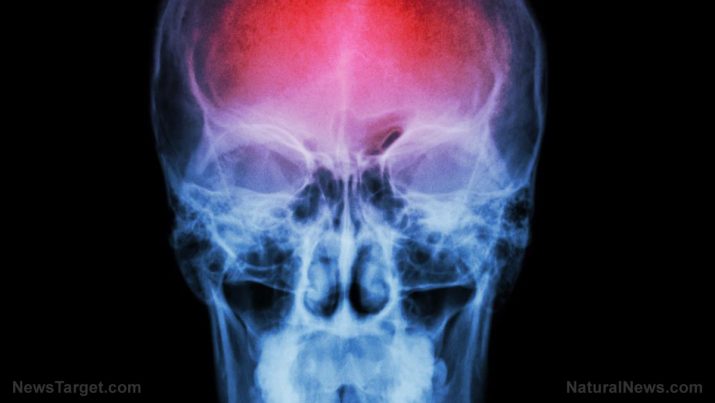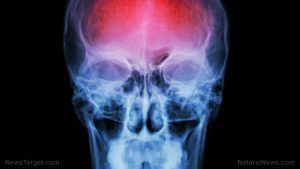
Subarachnoid Hemorrhage – causes, side effects and treatments at NaturalPedia.com
Friday, July 27, 2018 by Michelle Simmons
http://www.naturalpedia.com/subarachnoid-hemorrhage-causes-side-effects-and-treatments-at-naturalpedia-com.html

Subarachnoid hemorrhage is the term used to refer to the bleeding in the space between the brain and the surrounding membrane, also known as the subarachnoid space. This space is filled with cerebrospinal fluid which serves as a floating cushion to protect the brain. When blood is released into the subarachnoid space, it irritates the lining of the brain, puts more pressure on the brain, and injures brain cells. At the same time, the area of the brain that previously received oxygen-rich blood from the affected artery is now deprived of blood, resulting in a stroke. Subarachnoid hemorrhage is a life-threatening type of stroke. It can occur as a result of a ruptured aneurysm or head injury.
Subarachnoid hemorrhage can also occur due to a bleeding disorder, bleeding from a tangle of blood vessels called an arteriovenous malformation, or the use of blood thinners. This condition is often seen in the older people who have fallen and hit their head. Among young people, the most common injury leading to subarachnoid hemorrhage is motor vehicle crashes.

Known symptoms of subarachnoid hemorrhage
The main symptom of subarachnoid hemorrhage is a sudden, severe headache, which is more intense at the base of the skull. It is frequently described as the worst headache people have ever experienced. In some cases, people may experience a popping sensation in their head before the hemorrhage starts. Other signs of subarachnoid hemorrhage include neck pain, numbness throughout the body, shoulder pain, seizures, confusion, irritability, sensitivity to light, decreased vision, double vision, nausea, vomiting, and rapid loss of alertness.
A lot of people with subarachnoid hemorrhage will die, even before reaching the hospital. Some will have some degree of permanent disability. This is because of the damage caused to the brain by the initial bleeding and by the shortage of oxygen to the brain which follows it. Only around one in four people survive subarachnoid hemorrhage well enough to live independently. This more likely happens if the bleed is small, if the initial symptoms are less severe, and if the patient is younger.
Body systems harmed by subarachnoid hemorrhage
The body systems harmed by subarachnoid hemorrhage are the nervous system, ocular system, and cardiovascular system.
List of foods or nutrients that prevent subarachnoid hemorrhage
Foods that can prevent stroke, such as subarachnoid hemorrhage, include the following:
- Almonds
- Bananas
- Black beans
- Blueberries
- Mackerel
- Oatmeal
- Organic milk
- Pumpkin seeds
- Salmon
- Spinach
- Sweet potatoes
- Tuna
Treatments, management plans for subarachnoid hemorrhage
Treatment for a brain hemorrhage like subarachnoid hemorrhage will depend on the cause of the bleeding, the extent of the bleeding, and tissue damage. If the swelling is severe, immediate surgery will be needed. Medications can be used to treat the bleeding and reduce the symptoms. Natural treatments for brain hemorrhages include garlic, ginger, turmeric, green tea, foods rich in beta-carotene, Epsom salt baths, gentle massage, gingko biloba, acupressure, hawthorn, and homeopathy.
Where to learn more
- Dramatically effective natural treatment found for stroke-caused brain damage
- Vitamin E better than any medication at saving brain tissue during a stroke
- Ginkgo Reduces Brain Damage from Stroke by 50 Percent
- Omega-3 DHA fat dampens brain inflammation to lower stroke risk, improves cognitive function
- Babies of obese mothers at high risk of brain damage, stroke, heart attack and asthma
Summary
Subarachnoid hemorrhage is a life-threatening type of stroke that occurs due to the bleeding in the space between the brain and the surrounding membrane.
Subarachnoid hemorrhage causes a sudden, severe headache, which is more intense at the base of the skull.
Subarachnoid hemorrhage also causes neck pain, numbness throughout the body, shoulder pain, seizures, confusion, irritability, sensitivity to light, decreased vision, double vision, nausea, vomiting, and rapid loss of alertness.
Subarachnoid hemorrhage can result in a permanent disability or death.
Subarachnoid hemorrhage can be treated with surgery, medications, and natural remedies, such as garlic, ginger, turmeric, green tea, foods rich in beta-carotene, Epsom salt baths, gentle massage, gingko biloba, acupressure, hawthorn, and homeopathy.
Sources include:
Tagged Under: Tags: Subarachnoid hemorrhage





